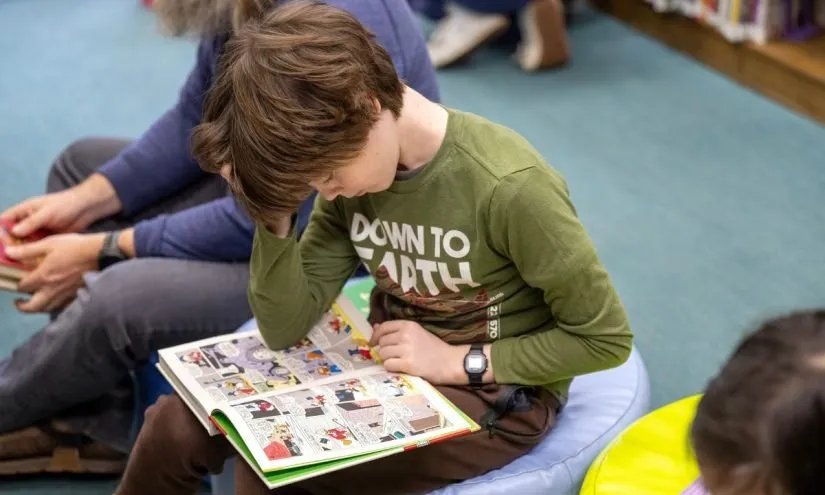Do Kids Really Stop Learning To Read And Start Reading To Learn After Third Grade?

Do Kids Really Stop Learning To Read And Start Reading To Learn After Third Grade?
Get stories like this delivered straight to your inbox.Sign up for The 74 Newsletter
Get و stories و like – تفاصيل مهمة
With American schools facing a literacy crisis, the “Mississippi miracle” has become the poster child for improved reading instruction. But it could just as easily be a cautionary tale because of a stubborn myth: that after third grade, students stop learning to read and start reading to learn.
The adage is ubiquitous in education circles, and it’s a catchy way of underscoring the importance of early literacy. Indeed, being on track by grade three is a crucial milestone that correlates to long-term academic success.
But literacy isn’t a switch that flips from decoding words in third grade to independently comprehending text in fourth. Decoding and comprehension are like two wires that must remain connected for the lights to go on. Students need to build foundational skills, vocabulary and background knowledge throughout — at least — their K-8 years.
Mississippi’s test scores provide a clear illustration. In 2013, the state ranked 49th in National Assessment of Education Progress fourth grade reading scores, with just 21% of students at or above “proficient.” By 2024, that figure was 32%, putting Mississippi in the top half of states for fourth grade literacy. But Mississippi’s eighth grade scores peaked at just 25% proficiency in 2017 and 2019, and have since fallen to 23%.
in و and و of – تفاصيل مهمة
And this is the state that has been, perhaps, the most successful at improving literacy instruction.
So what’s happening?
Those eighth graders hadn’t forgotten what they had learned in elementary school. They could still sound out “c-a-t.” But those three letters make the sound “kaysh” in words like “education” or “vacation,” and most schools do not explicitly teach students that transition.
So students struggle with decoding words as the vocabulary gets tougher. If they can’t decode multisyllabic words, they won’t comprehend complex text.
they و So و in – تفاصيل مهمة
While many statesto their credit, have moved aggressively to encourage proven reading instruction strategies in early literacy instruction, much of the education system — from standards to curriculum to teacher training — remains centered around the third grade myth. Schools simply stop teaching kids to decode words far too early.
Literacy instruction aligned with the science of reading places a heavy emphasis on screening for phonemic awareness, phonics and fluency, materials and teacher training aimed at helping K-3 students learn to sound out and decode words of one and two syllables. This shift is a crucial step forward, but it’s not enough.
to و and و a – تفاصيل مهمة
If states want to see their investments in literacy pay off then, they need to reevaluate how they think about the crucial middle years — grades 4 through 8.
A 2019 study revealed that nearly 1 in 5 eighth graders was below what it called the decoding threshold —a baseline level of reading fluency students need before they can successfully comprehend. Above the threshold, comprehension varies; below it, kids don’t have a shot.
Watershed Advisors analyzed reading standards across the country and found that just five states— Arkansas, Minnesota, Hawaii, Idaho and West Virginia — include advanced foundational skills beyond grade 5. And while nearly every state requires universal K-3 literacy screening, only Idaho and Kansas require this testing for older students. Meanwhile, a RAND study found that grade 3-8 teachers “need knowledge and training on how to help students who are experiencing difficulties with word reading, vocabulary and reading comprehension.”
Fortunately, research also shows a path forward. In pilot testing through funded research out of Reading Reimagined (an AERDF program), projects such as Read STOP Write and BIG Words can improve decoding and comprehension together by focusing on advanced foundational reading skills such as syllabication, spelling, fluency, morphology and vocabulary acquisition. And a 2023 NWEA study found that a whole-class focus on fluency for middle schoolers improved reading scores for students in the bottom half.
and و reading و a – تفاصيل مهمة
To stop the middle-grades malaise, states should commit themselves to adopting comprehensive policy agendas aimed at teaching advanced foundational literacy skills in addition to supporting comprehension in grades 4 through 8.
First, they should update their late elementary and middle grade standards to require explicit, evidence-based instruction on skills such as morphology, multisyllabic decoding and reading fluency that are crucial for students’ ability to work through grade-level texts.
Second, they should mandate screenings that include a focus on the advanced decoding skills at the beginning of each year for all students in grades 3 through 9 — understanding that tests designed to measure early decoding skills are not appropriate for older students.
Third, states should partner with publishers of high-quality curricula to ensure updated standards are reflected in materials used across the state.
to و should و skills – تفاصيل مهمة
Fourth, they should partner with high-quality professional learning organizations to provide teachers, teacher coaches, principals and district leaders with training and ongoing support on the new screeners and curricula.
Finally, they should work with districts and schools to observe whether educators are shifting their practice and students are learning as a result, and use this information to adjust the state’s overall strategy
and و to و the – تفاصيل مهمة
One thing the third grade myth gets right is that reading is fundamental to learning. If kids can’t read confidently, they will struggle across subjects.
States’ commitment to the science of reading across geographic and political lines is one of few recent bright spots in American education. Now it’s time to finish the job.
to و the و of – تفاصيل مهمة
Did you use this article in your work?
We’d love to hear how The 74’s reporting is helping educators, researchers, and policymakers.Tell us how
how و و We’d – تفاصيل مهمة
Disclaimer: This news article has been republished exactly as it appeared on its original source, without any modification.
We do not take any responsibility for its content, which remains solely the responsibility of the original publisher.
Author:Rebecca Kockler and Kunjan Narechania
Published on:2025-11-20 23:30:00
Source: www.the74million.org
Disclaimer: This news article has been republished exactly as it appeared on its original source, without any modification.
We do not take any responsibility for its content, which remains solely the responsibility of the original publisher.
Author: uaetodaynews
Published on: 2025-11-20 21:44:00
Source: uaetodaynews.com





